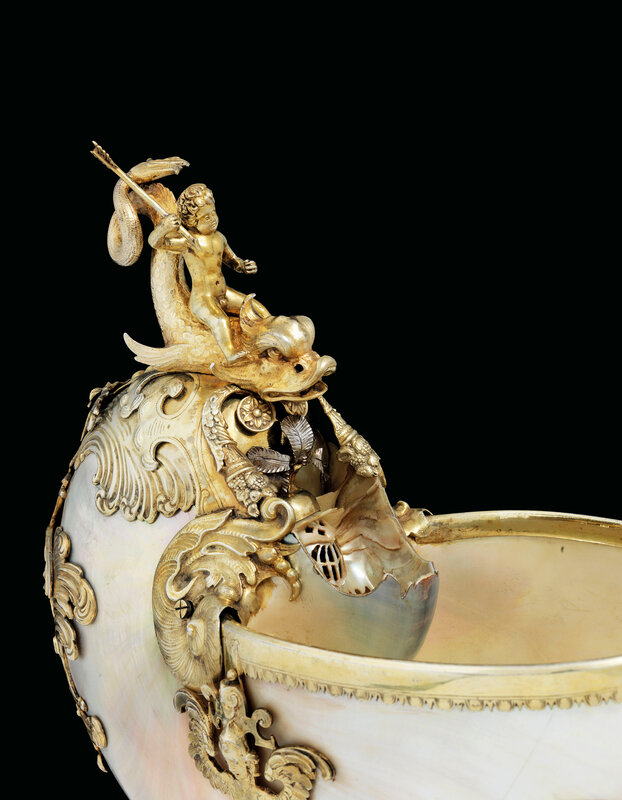A German parcel-gilt silver-mounted nautilus shell cup mark of Albrecht Von Horn, Augsburg, 1647-1651, with some later mounts
Lot 2. A German parcel-gilt silver-mounted nautilus shell cup, mark of Albrecht Von Horn, Augsburg, 1647-1651, with some later mounts;15 in. (38.2 cm.) high . Estimate GBP 50,000 - GBP 80,000 (USD 63,300 - USD 101,280). Price realised GBP 395,250. © Christie's Images Ltd 2019.
On domed lobed foot chased with auricular masks, the stem formed as a merman kneeling on waves supporting the shell on one shoulder, the shell enclosed by four straps, the side straps formed as winged caryatids, the front strap with winged satyr holding a basket of fruit, the back strap with a large grotesque mask framed by wave like scrolls probably 18th century to cover damage to the shell, the finial formed as a putto seated upon a scaly dolphin holding in his right hand an arrow probably later, the shell carved with scrolls and central visor topped with a later plume of feathers and framed by later cornucopiae, marked on base and with inventory number 385 painted in red inside the shell.
Provenance: Baron Nathaniel von Rothschild (1836-1905), Vienna.
Rothschild collection.
Literature: M. Rosenberg, Der Goldschmiede Merkzeichen, vol. 1, Frankfurt, 1922, p. 91 no. 508A.
C.Rönnau, Der Augsburger Goldschmied Albrecht von Horn (1581-1664), Ludwig-Maximilians-Universität München, 2014.
ALBRECHT VON HORN
Albrecht von Horn’s mark was for a long time confused with the marks of the fellow goldsmiths Andreas Hamburger and Andreas Hornmann (Herman), leading to a number of misattributions, not assisted by his complicated career path. Von Horn was born in Kiel in 1581, entering Hans II Hintze's workshop in Lübeck as an apprentice in 1593. After seven years of apprenticeship in Lübeck, he travelled as a freeman for five years arriving in Augsburg in 1605 where he worked in the workshop of Hans Jakob I Bair. He first applied to become master in Augsburg in 1609 but failed, despite the support of Bair. Indeed disregarding experience, skill and age, Augsburg required all applicants to complete an eight year apprenticeship before being eligible for the title of master goldsmith. In 1614 he applied once more, but was required to finish his masterpiece in the workshop of the Geschaumeister (inspection master) Johannes (Hans) I Lencker or his colleague Boas Ulrich,. Without doubt the guild also made it complicated for 'foreigners', giving priority to Augsburg born apprentices. Von Horn was finally received as master in 1616. He went on to have a prolific career as demonstrated by the Guild records in the city archives. He produced much secular silver as well as domestic pieces. Von Horn remained active up to 1660, dying in 1664 approaching 80 years of age.
AN EXPERT MODELLER OF FIGURES
Surviving works by Von Horn show that he excelled in modelling figures; religious subjects such as 'Christ at the Column', now in the Flagg Collection, Milwaukee Art Museum, and classical subjects such as the merman stem of this nautilus. Here he has managed to combine a classical nude with baroque pathos and realistic details. Albrecht von Horn based his figures on well established models, notably those of David Heschler (1611-1667) and his master, the German sculptor Georg Petel (1601-1635), who was active in Augsburg and therefore a popular source of inspiration for local goldsmiths. The merman figure of this nautilus is indeed reminiscent of Heschler's Hercules Supporting the Heavenly Sphere Cup, dated circa 1630–1640, in the collection of the Art Gallery of Ontario. This distinctive kneeling figure was probably a favourite of Von Horn as he also used it for a set of salt-cellars dated 1640-1650, one of which is now in the collection of Giovanni Züst in Kirchhoferhaus, St. Gallen, and for another nautilus cup in the Esterhazy Collection at Eisenstadt, Austria. He is also regarded as one of the leading Augsburg goldsmiths in the field of family altars for the oratory or bedchamber. He made finely cast reliefs after Michelangelo featuring not only detailed figures but also richly composed backgrounds, evident in his Deposition of Christ dated 1625/1630, now in the Bayerisches Nationalmuseum in Munich.
Christie's. Masterpieces from a Rothschild Collection, London, 4 July 2019

/https%3A%2F%2Fprofilepics.canalblog.com%2Fprofilepics%2F1%2F0%2F100183.jpg)
/https%3A%2F%2Fstorage.canalblog.com%2F03%2F02%2F119589%2F96711876_o.jpg)
/https%3A%2F%2Fstorage.canalblog.com%2F11%2F31%2F119589%2F94773502_o.jpg)
/https%3A%2F%2Fstorage.canalblog.com%2F20%2F83%2F119589%2F94772815_o.jpg)
/https%3A%2F%2Fstorage.canalblog.com%2F26%2F72%2F119589%2F75604929_o.jpg)
/https%3A%2F%2Fstorage.canalblog.com%2F59%2F60%2F119589%2F26458628_o.jpg)









/http%3A%2F%2Fstorage.canalblog.com%2F98%2F36%2F119589%2F129512727_o.jpg)
/http%3A%2F%2Fstorage.canalblog.com%2F06%2F92%2F119589%2F129511984_o.jpg)
/http%3A%2F%2Fstorage.canalblog.com%2F95%2F20%2F119589%2F129500898_o.jpg)
/http%3A%2F%2Fstorage.canalblog.com%2F79%2F29%2F119589%2F129500486_o.jpg)